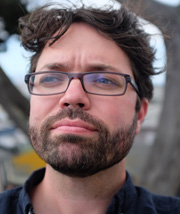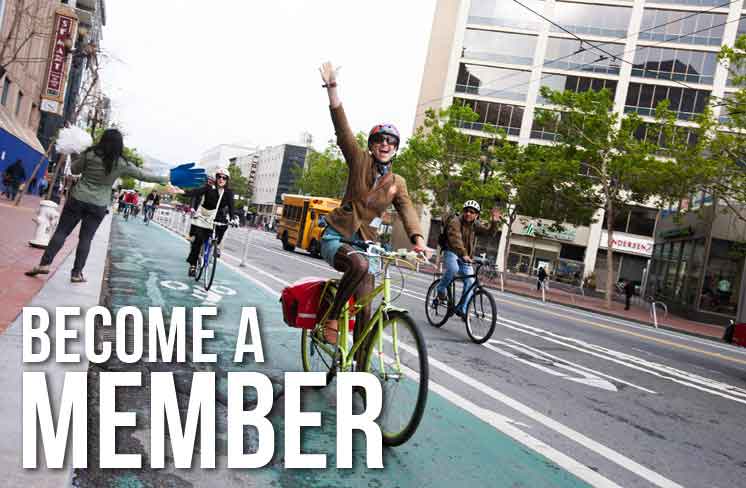Candidate Facts
 |
Name: Reed Martin Campaign Website: mayorgrandsf.org |
Candidate Questionnaire
All official candidates were contacted and given the opportunity to answer our Candidate Questionnaire. Any candidate responses edited for length and clarity have been marked as such.
1. Do you ride a bicycle in the city?
Yes
2. If yes, for what purpose(s) and how often? How do you most commonly commute to work?
I generally ride my personal bike for recreation or occasional commuting. I am also an avid rider of Bay Area Bike Share to get around downtown, and am excited for the (long overdue) expansion. I was a Bike to Work captain for my prior workplace, though I recently changed work locations and bike much more rarely, as I unfortunately don’t feel that the routes are safe enough for me to ride daily.
3. The City has established a goal to at least double the number of bike trips in the next 3 years. Do you support this goal?
Yes!
If yes, what would you do as Mayor or Supervisor to help the city realize it?
The fastest way to this goal is through the bike share program. In conjunction with this launch, let’s make Bike-to-Work an official city event, celebrating the bicycle. One day per week for the month of May, let’s shut down specific corridors to private vehicles and ensure safe, relaxed, inviting biking for people of all ages. Leading by example, demonstrating what we could have, is the best way to make progress toward this goal.
4. Civic leaders, agencies and departments embraced Vision Zero in 2014, which aims to eliminate traffic fatalities and serious injuries by 2024 through engineering, education and enforcement strategies. Do you support Vision Zero?
Yes, though I feel we must move more quickly than 2024.
As Mayor or Supervisor, will you prioritize funding and policy decisions based on Vision Zero?
Yes! It’s important to recognize that safety is a byproduct of streets that are designed for overall mobility and humanity, rather than speed.
5. Research has shown that the most effective way to boost the number of people bicycling and improve the bicycling experience is to designate dedicated space through physically separated bike lanes and traffic-calmed streets. The SF Bicycle Coalition has set out its Connecting the City initiative, an ambitious but achievable vision of 100 miles of crosstown bike lanes that are comfortable and inviting for people of all ages and abilities, connecting neighborhoods and helping locals and visitors to shop, work and play more often by bike. Reconfiguring our streets to include crosstown bike lanes and other “low stress” bike routes will draw concern from some citizens who are skeptical of this next-generation infrastructure and who oppose re-programming any existing on-street car parking or traffic lanes for safer biking.
Do you support the creation of continuous, crosstown bike lanes — Connecting the City — even acknowledging that there will be some skepticism to inevitable changes?
Yes! I applaud the Bike Coalition for its work in this space. Having greater options that are safe, quiet and sustainable fall strongly in line with the city’s own elected goals. As I’ve reached out to community members around the city, I’ve found more common ground than the narrative might indicate. It’s important to stress how an increase in biking in San Francisco will lead to fewer cars, more available parking, and less congestion.
6. The SF Bicycle Coalition has advocated for the City to increase its spending on bicycling improvements to better reflect the SFMTA’s Strategic Plan goal to reach eight percent of trips by bike by 2018. As Mayor or Supervisor, will you support leveling the playing field for all modes of transportation by ensuring that the level of funding for bicyclists at least matches the proportion of San Franciscans who bike?
Yes!
7. The affordability of transportation is a growing concern for many San Franciscans. For most residents, particularly low-income families, transportation is the second-highest cost of living after housing. As Mayor or Supervisor, how will you promote bicycling as an affordable transportation choice, particularly among households overburdened by transportation and housing expenses?
One of the most underrated discussions surrounding affordability in San Francisco is transportation. AAA estimates the cost of car ownership and operation at anywhere from $9,000 – $12,000 per year. That’s more than the average San Franciscan spends per month on food, clothing, personal care, and even alcohol…combined. Implementing dedicated cycle tracks and better bike safety measures is one of the lowest-cost ways to help improve affordability in San Francisco.
8. Market Street is San Francisco’s most well-traveled corridor, with a quarter of a million daily transit vehicle boardings on or under it each weekday and more daily bike trips than almost any other street in the United States. The City is working on a Better Market Street plan that calls for limiting private vehicle thru-traffic, creating a continuous, physically separated bikeway the full length of Market Street, while also enhancing transit and pedestrian travel along the corridor. Would you support this plan?
Yes! I currently sit on the Citizen Advisory Committee for Better Market Street. I strongly advocate for better transportation options along Market Street, including removing private vehicle traffic entirely. We need to ensure not only safe, comfortable, and inviting bike lanes along Market Street, but safe high-speed commuter-oriented bike lanes along Mission.
9. Next Fall, voters will have the chance to support a ballot measure to restore the Vehicle License Free to pre-Schwarzenegger levels and most likely an accompanying Equity Charter Amendment to provide an ongoing, progressive source of funding for transportation priorities in San Francisco, including safer walking and biking conditions and improved transit. Will you publicly support and actively campaign for this measure?
Yes! I have actively campaigned for the Vehicle License Fee as a member of the executive board of the San Francisco Transit Riders.
If yes, will you also support bridge-funding for the transportation funding gap until this funding measure is active?
Yes!
10. San Francisco has recently joined a growing list of major cities with sophisticated bike sharing programs. To succeed and bring access closer to many of our residents, this program will require significant expansion to neighborhoods across the city. This will require additional public space and right of way, and may require additional funding to provide low-cost access for low income residents. Do you commit to supporting and, if necessary, securing public funding and right of way to expand this cost-effective, innovative new transportation system to more San Francisco neighborhoods?
Yes! Ever since Mayor Newsom announced the plan for bike sharing in 2007, I’ve been waiting for a real bike share system in San Francisco. I had the opportunity to spend a summer in Paris in 2010, and bike sharing completely revolutionized how I experienced the city—and completely reinvigorated cycling in that city. My platform strongly advocates for access to a bike share within a 5 minute walk of every resident in San Francisco.
11. Double-parking in bike lanes is a major safety problem in San Francisco, often forcing people biking to swerve into dangerous traffic conditions. Will you prioritize a significant increase in the SF Police Department’s and the SFMTA’s Parking Control Officers’ enforcement of this problem?
Yes absolutely, though it’s equally as important to look beyond enforcement. My platform introduces the concept of “Paseos” — what I’m calling Human Streets. Global cities have long recognized that streets are about much more than driving; they sustain our communities. In San Francisco, we have a surprisingly low ratio of public plazas, pedestrian zones, and shared spaces when compared internationally. Instead, we continue to promote dangerously high speed traffic, and correspondingly high accident rates. By working to amend the California Vehicle Code to allow for slower speed limits and reclassifying neighborhood streets, we have the opportunity to reclaim streets for socializing, playing, exercising, and mobility, while reducing overall congestion, noise, pollution, and injuries. In conjunction with a network of residential and commercial human-focused streets, we have a clear connection of arteries, each of which has strong pedestrian protections and barriers as well as dedicated cycle tracks, minimizing conflicts between vehicles and people.
12. Significant concern exists around police enforcement of safe-driving laws in San Francisco. Do you support increased enforcement and accountability for all road-users focused around the five most dangerous driving actions (speeding, failing to stop for pedestrians in the crosswalk, improperly making a right-hand turn, running red lights, and failing to stop at stop signs)?
Yes, but again, it’s important that we go back and look at the purpose and design of our streets to more adequately design situations that prevent or strongly discourage these behaviors. Our wide streets practically invite speeding today. For example, I advocate for an FHWA pilot of near-side-only traffic lights, keeping drivers from entering crosswalks and putting lights at a human level.
13. Have you championed or strongly supported any other initiatives that are in line with the SF Bicycle Coalition’s mission of promoting bicycling for everyday transportation?
Through my work at SF Transit Riders, Better Market Street, and Director of Nextransit, I’m passionate about inclusive, safe, and human streets. I’ve worked with the city of Paris and MIT’s Smart Cities on mobility. I’ve advocated for VLF, Better Market Street, Polk Street, and 2014 Props A & B (and No on L!) We need a leader who can provide true vision for a better future for San Francisco; that vision begins in the streets.

